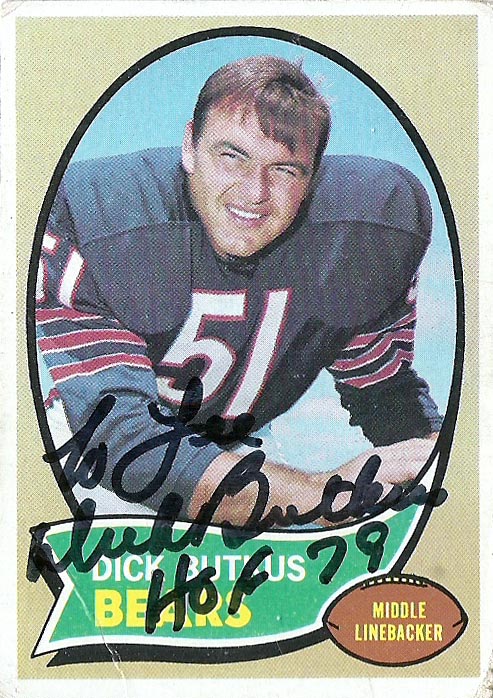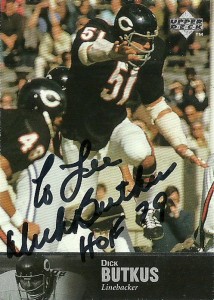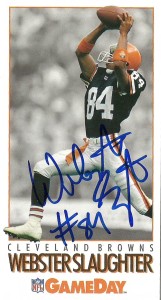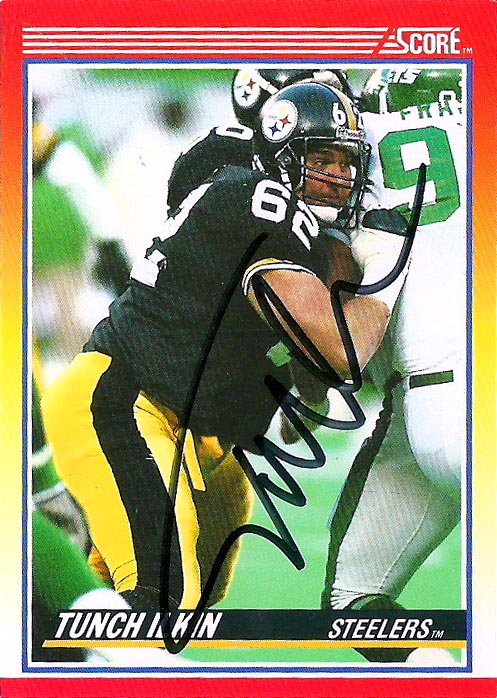
Card: Upper Deck Legends 1997, Topps 1971
Acquired: TTM 2012, C/o Home*
Sent: 11/14 Received: 12/23 (9 days)
*Signing fee enclosed
Dick Butkus is one of the NFL’s greatest prototypical linebackers ever to play the game and redefined the position for a generation with his dominating play and fearsome presence on the field. After an acclaimed career playing linebacker and center for the Fightin’ Illini, the Chicago Bears made Dick their #1 pick of the 1965 draft (3rd overall). The competing AFL Denver Broncos also made an offer, but Dick signed with his home state Bears and never looked back. The 1965 draft was a watershed draft for the Bears who hit on a couple of great names during the draft including Gale Sayers, Jim Nance, and Steve Delong, but the team never seemed to be able to gel and turn the corner – especially against the powerful Packers.
Still Butkus had quite a reputation around the league as being incredibly durable and reliable, -but also as a dirty player as well. Over his time with the Bears he led the team in nearly every defensive category every season, tallying a career high unofficial count of 18 sacks in 1967. Butkus was also an independent thinker who regularly challenged the league on many issues that impacted the sport, from working with the XFL against the NFL, to helping to revolutionize the league’s policies on injuries and medical opinions.
 A Bear legend even after his retirement, Butkus spent a few years doing commentary for the league, and endorsed many products and appeared in many different movies and TV shows. Butkus was elected to the NFL HoF in 1979, and was named head coach of the Chicago Enforcers for the XFL before they reshuffled the team prior to the season. Butkus was then promoted by the league to Director of XFL Competition as basically a rules enforcer. He’d appear in the first game and bolster the hopes of many that the XFL might challenge the NFL’s superiority, but by the 3rd week of the season, any of those dreams were dashed with sagging ratings. Butkus in the meantime remained committed to his foundation.
A Bear legend even after his retirement, Butkus spent a few years doing commentary for the league, and endorsed many products and appeared in many different movies and TV shows. Butkus was elected to the NFL HoF in 1979, and was named head coach of the Chicago Enforcers for the XFL before they reshuffled the team prior to the season. Butkus was then promoted by the league to Director of XFL Competition as basically a rules enforcer. He’d appear in the first game and bolster the hopes of many that the XFL might challenge the NFL’s superiority, but by the 3rd week of the season, any of those dreams were dashed with sagging ratings. Butkus in the meantime remained committed to his foundation.
I had seen that Dick was hit or miss through the mail but another collector had some successfrom him by writing on the back of the sending envelope “DONATION ENCLOSED” and enclosing a small donation. With that stroke of genius I set off to get the autograph one of the greatest linebackers in NFL history. I was pretty nervous about writing him and even called him ‘Mr. Butkus’ in the letter. Fans may have been able to get away with a smaller donation, however I felt that I could afford at least 20.00 a card for such a great player. Eventually he went to $51.00 an autograph- to not signing at all.
I’m pretty sure in 1995, while I was working opening stores for Best Buy and I was away from the autograph game, I encountered a throng of fans surrounding him for an autograph in the parking lot of the DC Airport.
Tac 1020 Sac N/a Fum 27 Int 22 Yds 166 Avg 7.5 Td 0 Lg n/a
EPITAPH:
10/5/23- It was announced today that Dick Butkus passed away in his sleep overnight, dying peacefully at his Malibu, FL home at the age of 80. No cause of death was given.

